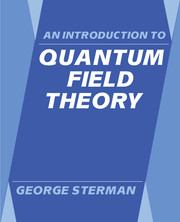Book contents
- Frontmatter
- Contents
- Preface
- PART I SCALAR FIELDS
- PART II FIELDS WITH SPIN
- PART III RENORMALIZATION
- PART IV THE NATURE OF PERTURBATIVE CROSS SECTIONS
- 12 Perturbative corrections and the infrared problem
- 13 Analytic structure and infrared finiteness
- 14 Factorization and evolution in high-energy scattering
- 15 Epilogue: Bound states and the limitations of perturbation theory
- APPENDICES
- References
- Index
12 - Perturbative corrections and the infrared problem
Published online by Cambridge University Press: 05 August 2012
- Frontmatter
- Contents
- Preface
- PART I SCALAR FIELDS
- PART II FIELDS WITH SPIN
- PART III RENORMALIZATION
- PART IV THE NATURE OF PERTURBATIVE CROSS SECTIONS
- 12 Perturbative corrections and the infrared problem
- 13 Analytic structure and infrared finiteness
- 14 Factorization and evolution in high-energy scattering
- 15 Epilogue: Bound states and the limitations of perturbation theory
- APPENDICES
- References
- Index
Summary
Renormalization makes it possible to compute perturbative corrections to lowest-order amplitudes and cross sections. The one-loop correction to the electron–photon vertex is an instructive example. Here we encounter a new kind of infinity, associated with very-long-wavelength photons. These ‘infrared’ divergences are well understood in quantum electrodynamics, and cancel in suitably defined cross sections. Yet another variety of on-shell infinity, the ‘collinear divergence’ arises in quantum chromodynamics (QCD), and in any other theory in which massless particles couple among themselves. Some of the resulting difficulties can be avoided by working with inclusive cross sections in the high-energy limit. The total and jet cross sections for e+e− annihilation into hadrons afford a wide range of experimental tests of QCD.
One-loop corrections in QED
Tensor structure and form factors
The fermion–photon vertex may describe the scattering of an electron or positron, or the annihilation or creation of a pair. We pick the scattering of an on-shell electron. The corresponding matrix element is where 〈(p2, σ2)(−)∣jμ(0)∣(p1, σ1)(−)〉, where jμ is the electromagnetic current. We shall use the notation ui for spinors u(pi, σi) below.
- Type
- Chapter
- Information
- An Introduction to Quantum Field Theory , pp. 369 - 410Publisher: Cambridge University PressPrint publication year: 1993



